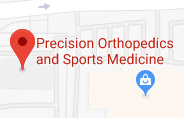Fractures of the hand and fingers
The hand is one of the most flexible and useful parts of our body. In the wrist, many small bones are connected to each other and help you perform various activities. Because of overuse of hand in various activities hands are more prone to injuries and you may suffer from sprains and strains; fractures when lifting and carrying heavy objects, hand injury while operating machinery, bracing against a fall, or sports-related injuries. Any injury to bones or the attached ligaments may cause pain and strain, thereby limiting the activities of hands and wrists. A broken wrist is among the most common broken injuries. Fracture is a break in the bone and sprain is the tear of the ligament, the connective tissue. Fracture or sprain limits the activities of hand and may be corrected.
Fractures: A fracture is a break in the bone, occurs when more force than the bearable limit is applied against a bone. Crushing injuries to the hand or wrist occurring due to high degree of force or pressure may also cause fractures. A fracture may cause severe pain, swelling, bruising or bleeding, discoloration of the skin and limit the mobility of the limb. Fracture of a finger bone can only be treated by using a cast or splint while the bone heals. Sometimes surgery may be needed where plates, pins or screws may be placed to keep the bone stable.
Finger fracture
Fingers are fine structures of the human body which assist in daily routine activities through coordinated movements. Any abnormality affecting the fingers can have a huge impact on quality of life of the patient. A finger fracture is usually a minor injury but if left untreated it may lead to major consequences due to interference with the specialized functions such as grasping or manipulating objects in the palm. A fracture of the finger may disrupt the alignment of the whole hand and cause pain and stiffness.
Diagnosis
The diagnosis of finger fracture is based on history, physical examinations and X-ray imaging to determine the type and severity of the fracture. X-rays are the most widely used diagnostic tools for the evaluation of fractures.
The objective of early fracture management is to control bleeding, prevent ischemic injury (bone death) and to remove sources of infection such as foreign bodies and dead tissues. The next step in fracture management is the reduction of the fracture and its maintenance. It is important to ensure that the involved part of the body returns to its function after fracture heals. To achieve this, maintenance of fracture reduction with immobilization technique is done by either non-operative or surgical method.
Medical Therapy
Non-operative (closed) therapy comprises of casting and traction (skin and skeletal traction).
- Casting: Closed reduction is done for any fracture that is displaced, shortened, or angulated. Splints and casts made up of fiberglass or plaster of Paris material are used to immobilize the limb.
- Traction: Traction method is used for the management of fractures and dislocations that cannot be treated by casting.
Surgical Therapy
- Open Reduction and Internal Fixation (ORIF):This is a surgical procedure in which the fracture site is adequately exposed and reduction of fracture is done. Internal fixation is done with devices such as Kirschner wires, plates and screws, and intramedullary nails.
- External fixation: External fixation is a procedure in which the fracture stabilization is done at a distance from the site of fracture. It helps to maintain bone length and alignment without casting.
Rehabilitation
Fractures may take several weeks to months to heal completely. You should limit your activities even after the removal of cast or brace so that the bone become solid enough to bear the stress. Rehabilitation program involves exercises and gradual increase in activity levels until the process of healing is complete.
2120 N. MacArthur Blvd
Suite 100
Irving, TX 75061
 Ph: (972) 438 4636
Ph: (972) 438 4636
 Fax:
(972) 438 2077
Fax:
(972) 438 2077

 Make an Appointment Online
Make an Appointment Online

 Shoulder
Shoulder Elbow
Elbow Wrist
Wrist Hand
Hand Patient Education
Patient Education Testimonials
Testimonials Map
& Location
Map
& Location Patient Forms
Patient Forms






